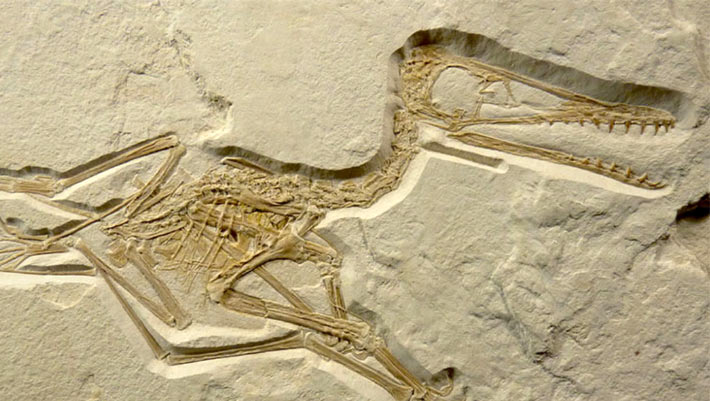A new genus and species of monofenestratan pterosaur being named Propterodacylus frankerlae documents the transition from the more ancient rhamphorhynchoid pterosaurs to the derived pterodactyloids.
Propterodacylus frankerlae lived during the Kimmeridgian age of the Late Jurassic epoch, around 150 million years ago.
The flying reptile had a moderately elongated skull around 9 cm (3.5 inches) in length and an estimated wingspan of about 55 cm (21.7 inches).
The species also had a very short tail and a small but functional fifth toe with two phalanges.
Propterodacylus frankerlae was a type of monofenestratan (Monofenestrata), a large group of pterosaurs that includes the family Wukongopteridae and the suborder Pterodactyloidea.
“Pterosaurs, the oldest vertebrate lineage that performed active flight, experienced a highly successful evolution throughout the Mesozoic,” Dr. Frederik Spindler of the Dinosaurier Museum Altmühltal wrote in his new paper.
“For most of their long research history any specimen could be classified as belonging to one of two major types, the more ancestral long-tailed Rhamphorhynchoidea and the derived stubby-tailed Pterodactyloidea.”
“The only short-faced pterosaurs, the rare Anurognathidae, are likewise short-tailed, but otherwise appear rhamphorhynchoid-grade and thus were commonly considered to nest deeply within the rhamphorhynchoid-grade.”
“A truly intermediary and thus convincingly transitional morphology between the major types remained unknown until the discovery of the Wukongopteridae.”
Dubbed the Painten pro-pterodactyloid, the fossil was found in the lower levels of the Rygol lime works quarry near Painten, Bavaria, Germany.
The specimen comprises a complete and fully articulated skeleton with soft tissue remains in the trunk region and wing actinofibrils.
“Propterodacylus frankerlae is a contemporary of the oldest known Archaeopteryx from a neighboring basin,” the paleontologist said in the paper.
According to Dr. Spindler, the discovery closes the greatest knowledge gap regarding the evolution of pterosaur morphology.
“Propterodacylus frankerlae represents a nearly perfect mix of rhamphorhynchoid-grade, wukongopterid, and derived pterodactyloid pterosaur traits,” he said.
“Similarities with the derived Pterodactyloidea comprise the skull shape and short tail.”
“Plesiomorphies shared with e.g., Wukongopteridae, which preclude Propterodactlyus from Pterodactyloidea, are the functional fifth toe and long caudal zygapophyses.”
“Intermediate conditions apply to the cervical elongation, metacarpal elongation, and reduced fifth toe.”
The paper was published online in the journal Palaeontologia Electronica.
_____
Frederik Spindler. 2024. A pterosaurian connecting link from the Late Jurassic of Germany. Palaeontologia Electronica 27 (2): a35; doi: 10.26879/1366

